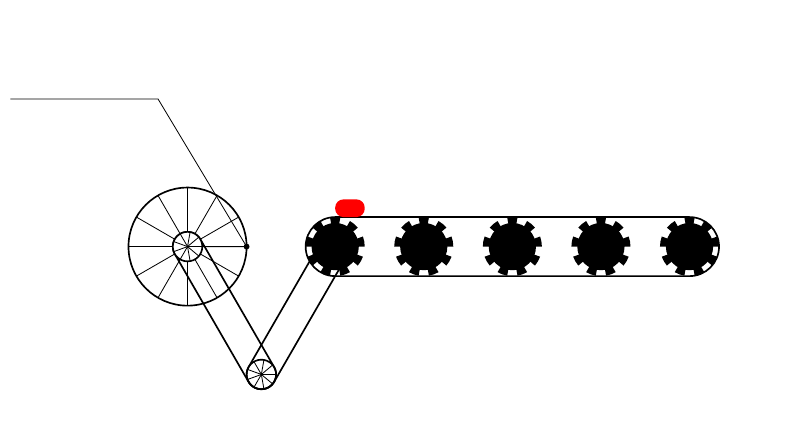
考虑以下 MWE:
\documentclass[border=5pt,tikz]{standalone}
\begin{document}
\foreach \n in {0,-10,...,-720}
{
\begin{tikzpicture}
\useasboundingbox (-3,-3) rectangle (10,4);
\draw[thick] (0,0) circle(1);
% \draw (0,0) -- (\n:1) node[fill=black,circle,inner sep=1pt] {} -- (-.5,{sin(\n)+2.5}) node[draw,rectangle,fill=white,minimum width=.5cm,minimum height=.7cm] {};
\draw (-3,2.5) -- (-.5,{sin(\n)+2.5}) -- (\n:1) node[fill=black,circle,inner sep=1pt] {} -- (0,0);
\foreach \x in {0,30,...,330}
{
\draw (0,0) -- (\x+\n:1);
}
\begin{scope}[xshift=2.5cm]
\foreach \y in {0,1.5,...,6}
{
% \draw (\y,0) circle(.5);
% \foreach \x in {0,30,...,330}
% {
% \draw (\y,0) -- ([xshift=\y cm]\x+\n:.5);
% }
\foreach \x in {0,40,...,320}
{
\fill (\y,0) -- ([xshift=\y cm]\x+\n:.5) arc(\x+\n:\x+\n+20:.5) -- cycle;
}
\fill (\y,0) circle(.4);
}
\draw[thick] (0,.5) -- (6,.5) arc(90:-90:.5) -- (0,-.5) arc(-90:-270:.5);
\end{scope}
\draw[rotate=-60,thick] (0,.25) arc(90:270:.25) --+ (2.5,0) arc(-90:90:.25) -- cycle;
\pgfmathsetmacro\xshift{cos(60)*2.5}
\pgfmathsetmacro\yshift{-sin(60)*2.5}
\draw[xshift=\xshift cm,yshift=\yshift cm,rotate=60,thick] (0,.25) arc(90:270:.25) --+ (2.5,0) arc(-90:90:.25) -- cycle;
\draw[thick,shift={({cos(60)*2.5},{-sin(60)*2.5})}] (0,0) circle(.25);
\draw[fill=white,thick] (0,0) circle(.25);
\foreach \x in {0,40,...,320}
{
\draw (0,0) -- (\x+\n:.25);
}
\begin{scope}[shift={({cos(60)*2.5},{-sin(60)*2.5})}]
\foreach \x in {0,40,...,320}
{
\draw (0,0) -- (\x+\n:.25);
}
\end{scope}
\pgfmathsetmacro\shift{2*cos(60)*2.5}
\pgfmathsetmacro\anothershift{-5.5*(\n/720)}
\fill[xshift=\shift cm,xshift=\anothershift cm,yshift=.5cm,rounded corners,red] (0,0) rectangle (.5,.3);
\end{tikzpicture}
}
\end{document}
输出如下:
我的问题是:如何更好地绘制旋转整个机制的杠杆,即如何保持实际长度,因为该部分是硬编码的,我正在寻找更精确的解决方案。
答案1
连接臂的长度由 设定\lenA。
\documentclass[border=5pt,tikz]{standalone}
\begin{document}
\foreach \n in {0,-10,...,-720}
{
\begin{tikzpicture}
\useasboundingbox (-3,-3) rectangle (10,4);
\draw[thick] (0,0) circle(1);
% \draw (0,0) -- (\n:1) node[fill=black,circle,inner sep=1pt] {} -- (-.5,{sin(\n)+2.5}) node[draw,rectangle,fill=white,minimum width=.5cm,minimum height=.7cm] {};
\def\lenA{3}%
\pgfmathsetmacro{\yB}{sin(\n)}%
\pgfmathsetmacro{\xB}{cos(\n)}%
\pgfmathsetmacro{\xA}{\xB-sqrt(\lenA*\lenA-\yB*\yB)}%
\draw[blue] (\xA,0) -- (\xB,\yB);
%\draw (-3,2.5) -- (-.5,{sin(\n)+2.5}) -- (\n:1) node[fill=black,circle,inner sep=1pt] {} -- (0,0);% levers
\foreach \x in {0,30,...,330}% spokes
{
\draw (0,0) -- (\x+\n:1);
}
\begin{scope}[xshift=2.5cm]
\foreach \y in {0,1.5,...,6}
{
% \draw (\y,0) circle(.5);
% \foreach \x in {0,30,...,330}
% {
% \draw (\y,0) -- ([xshift=\y cm]\x+\n:.5);
% }
\foreach \x in {0,40,...,320}
{
\fill (\y,0) -- ([xshift=\y cm]\x+\n:.5) arc(\x+\n:\x+\n+20:.5) -- cycle;
}
\fill (\y,0) circle(.4);
}
\draw[thick] (0,.5) -- (6,.5) arc(90:-90:.5) -- (0,-.5) arc(-90:-270:.5);
\end{scope}
\draw[rotate=-60,thick] (0,.25) arc(90:270:.25) --+ (2.5,0) arc(-90:90:.25) -- cycle;
\pgfmathsetmacro\xshift{cos(60)*2.5}
\pgfmathsetmacro\yshift{-sin(60)*2.5}
\draw[xshift=\xshift cm,yshift=\yshift cm,rotate=60,thick] (0,.25) arc(90:270:.25) --+ (2.5,0) arc(-90:90:.25) -- cycle;
\draw[thick,shift={({cos(60)*2.5},{-sin(60)*2.5})}] (0,0) circle(.25);
\draw[fill=white,thick] (0,0) circle(.25);
\foreach \x in {0,40,...,320}
{
\draw (0,0) -- (\x+\n:.25);
}
\begin{scope}[shift={({cos(60)*2.5},{-sin(60)*2.5})}]
\foreach \x in {0,40,...,320}
{
\draw (0,0) -- (\x+\n:.25);
}
\end{scope}
\pgfmathsetmacro\shift{2*cos(60)*2.5}
\pgfmathsetmacro\anothershift{-5.5*(\n/720)}
\fill[xshift=\shift cm,xshift=\anothershift cm,yshift=.5cm,rounded corners,red] (0,0) rectangle (.5,.3);
\end{tikzpicture}
}
\end{document}



